Baklava, a delectable pastry with layers of crispy phyllo dough and a sweet, nutty filling, is a beloved dessert that originated in the Middle East. Its rich flavors and delicate textures have made it a popular treat all around the world. In this article, I will guide you through the process of making baklava from scratch, so you can enjoy this savory delight in the comfort of your own kitchen.
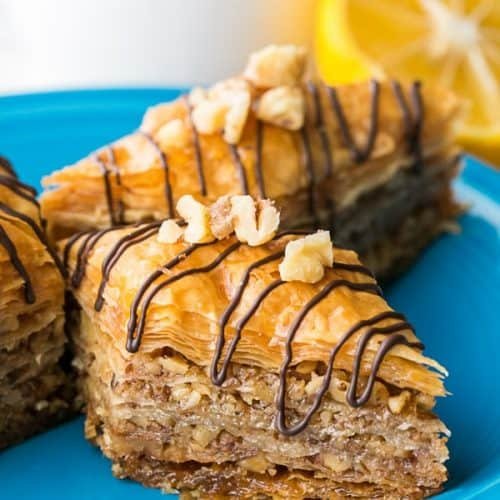
A Brief History of Baklava
Baklava has a long and fascinating history that dates back to the Byzantine Empire. It is believed to have originated in the imperial kitchens of Topkapi Palace in Istanbul, Turkey, during the 15th century. From there, it spread throughout the Ottoman Empire and eventually made its way to various countries in the Middle East, the Mediterranean, and beyond.
Ingredients Needed for Baklava
To make baklava, you will need the following ingredients:
• Phyllo dough: This thin, unleavened dough can be found in the frozen section of most grocery stores.
• Nuts: Traditionally, baklava is made with a mixture of walnuts, pistachios, and almonds. However, you can use any nuts of your choice.
• Sugar: Both granulated and powdered sugar are used to sweeten the filling and the syrup.
• Butter: Melted butter is brushed between the layers of phyllo dough to give baklava its crispy texture.
• Spices: Ground cinnamon and a hint of cloves or cardamom add warmth and depth to the flavor of baklava.
• Honey: A fragrant honey or saffron syrup is poured over the baked baklava, adding a sweet and sticky glaze.
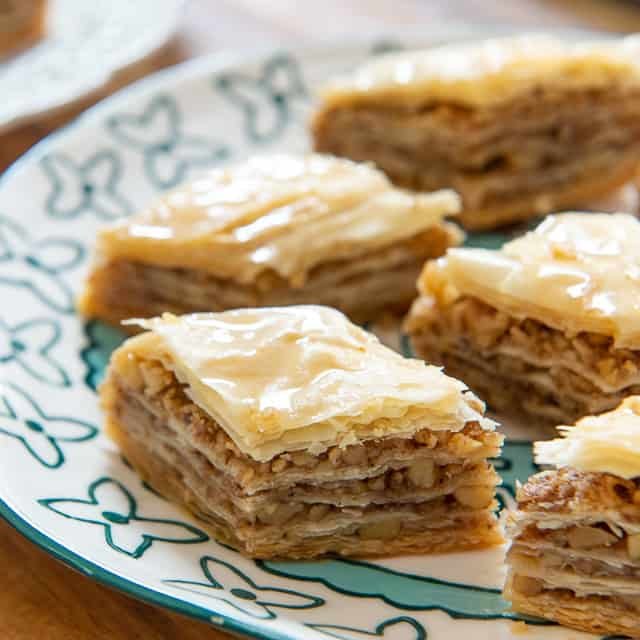
Step-by-Step Guide on Making Baklava
- Thaw the phyllo dough according to the package instructions. It is important to handle the dough gently to prevent it from tearing.
- Prepare the nut filling by combining the chopped nuts, sugar, and spices in a bowl. Mix well to ensure the flavors are evenly distributed.
- Preheat your oven to the specified temperature.
- Brush a baking dish with melted butter to prevent the baklava from sticking.
- Place a sheet of phyllo dough in the baking dish and brush it with melted butter. Repeat this process, layering the dough and butter, until you have used half of the phyllo sheets.
- Sprinkle a generous amount of the nut filling over the layered phyllo dough.
- Continue layering the remaining phyllo sheets, brushing each one with butter, and sprinkling the nut filling in between.
- Once all the layers are stacked, use a sharp knife to cut the baklava into diamond or square shapes.
- Bake the baklava in the preheated oven until it turns golden brown and crispy.
- While the baklava is baking, prepare the honey syrup by combining honey, sugar, and water in a saucepan. Heat over medium heat until the sugar dissolves and the syrup thickens slightly.
- Once the baklava is out of the oven, pour the warm honey syrup evenly over the top, allowing it to seep into the layers.
- Allow the baklava to cool completely before serving to allow the flavors to meld together.
Tips and Tricks for a Perfect Baklava
• Thaw the phyllo dough in the refrigerator overnight for best results.
• Keep the phyllo dough covered with a damp kitchen towel while working with it to prevent it from drying out.
• Use a sharp knife to cut the baklava to ensure clean and even slices.
• Let the baklava cool completely before pouring the honey syrup over it. This helps the syrup penetrate the layers and creates a moist and flavorful dessert.
• Store the baklava in an airtight container at room temperature for up to a week. It actually tastes better the day after it is made, as the flavors continue to develop.
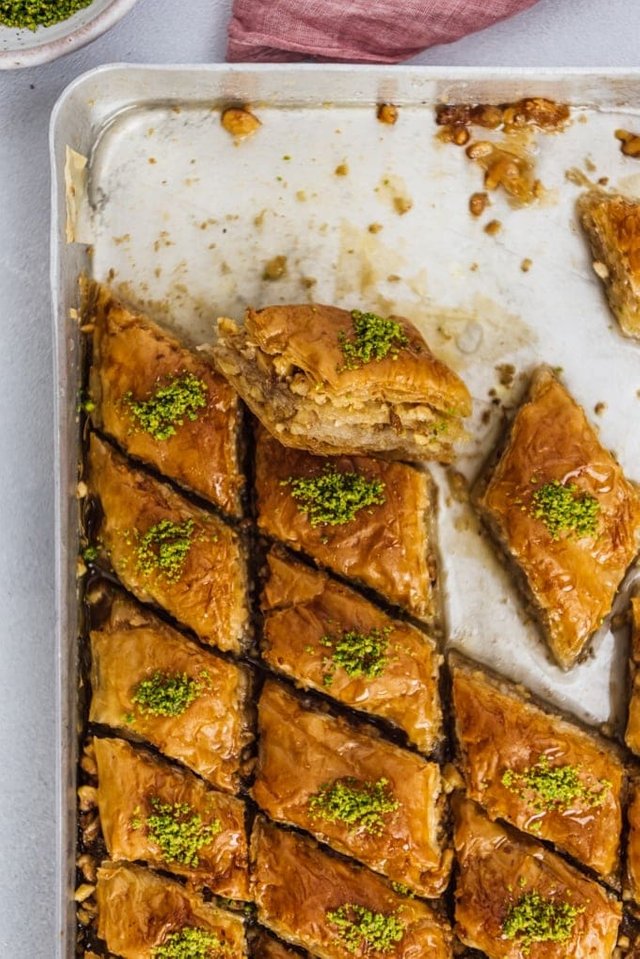
Variations and Substitutions for Baklava
While the traditional baklava recipe is a classic favorite, there are endless variations and substitutions you can try to put your own twist on this delightful dessert. Here are a few ideas:
• Nut Variations: Experiment with different types of nuts such as cashews, pecans, or hazelnuts. You can also combine multiple nuts to create unique flavor profiles.
• Fruit Fillings: Add a fruity twist to your baklava by incorporating dried fruits like apricots, dates, or figs into the nut filling.
• Chocolate Lover's Baklava: Sprinkle some chocolate chips or drizzle melted chocolate between the layers for a decadent chocolatey version.
• Savory Baklava: Swap the sweet ingredients for savory ones like cheese, herbs, and spices for a unique and unexpected appetizer or side dish.
Serving and Storing Baklava
Baklava is best enjoyed at room temperature. Serve it as a dessert after a meal or as a sweet treat with a cup of tea or coffee. You can also impress your guests by plating it with a dollop of whipped cream or a scoop of vanilla ice cream.
Store any leftover baklava in an airtight container at room temperature. Avoid refrigerating it, as the moisture from the fridge can make the pastry lose its crispiness. Properly stored baklava can last up to a week, although it is unlikely to last that long once you discover how irresistible it is!
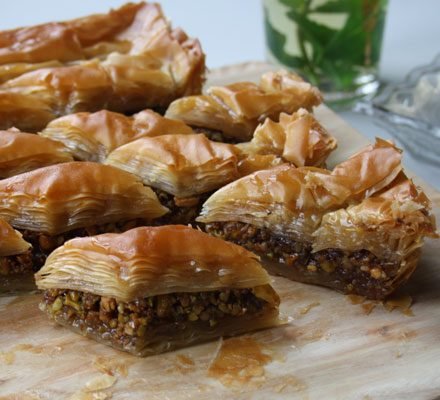
Frequently Asked Questions about Making Baklava
- Can I use store-bought baklava instead of making it from scratch? While store-bought baklava is readily available, making it from scratch allows you to customize the flavors and ensures a fresher and more satisfying experience.
- Can I freeze baklava? Yes, you can freeze baklava. Once it is fully cooled, wrap it tightly in plastic wrap and then in aluminum foil. It can be stored in the freezer for up to three months.
- Do I have to use all the nut filling? The amount of nut filling you use is flexible. You can adjust it according to your taste preferences. Just be careful not to overfill the layers, as it may cause them to separate while baking.
Baklava Recipes from Around the World
Baklava has gained popularity worldwide, and each culture has put its own spin on this delightful dessert. Here are a few variations from different parts of the world:
• Greek Baklava: Greek baklava is often made with a combination of walnuts and almonds and is typically flavored with cinnamon and cloves. It is then soaked in a honey syrup infused with lemon juice.
• Turkish Baklava: Turkish baklava is renowned for its use of pistachios. The syrup used in Turkish baklava is often made with rosewater or orange blossom water, giving it a distinct floral aroma.
• Lebanese Baklava: Lebanese baklava is known for its delicate layers of phyllo dough and a filling made with a mixture of walnuts, pistachios, and cashews. It is usually flavored with a hint of cinnamon and cardamom.
• Armenian Baklava: Armenian baklava is typically made with a combination of walnuts and almonds. It is often distinguished by its diamond-shaped cut and a thicker layer of nut filling.
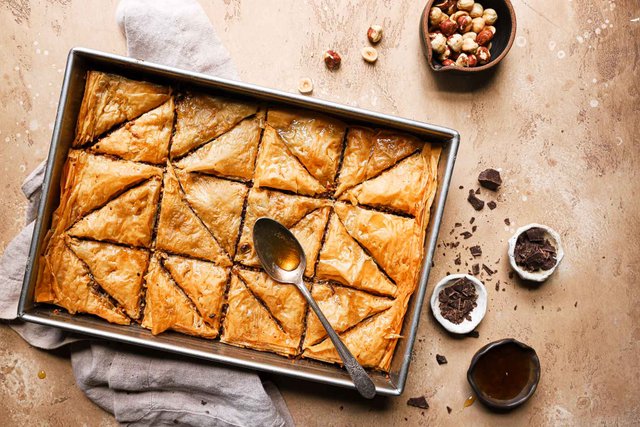
Making baklava from scratch may seem like a daunting task, but with the right ingredients, techniques, and a little bit of patience, you can create a delicious and impressive dessert that will delight your taste buds. Whether you stick to the traditional recipe or explore new variations, the process of making baklava is a labor of love that is well worth the effort. So, gather your ingredients, follow the step-by-step guide, and savor the sweet and nutty flavors of homemade baklava. Your friends and family will be amazed at your culinary prowess!